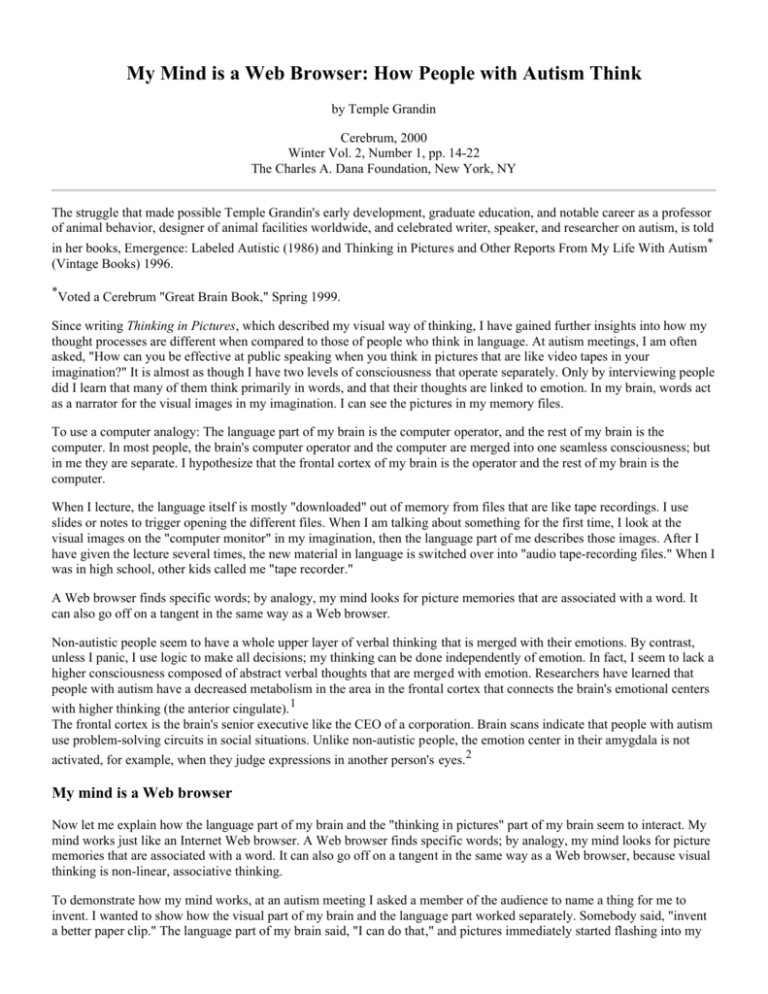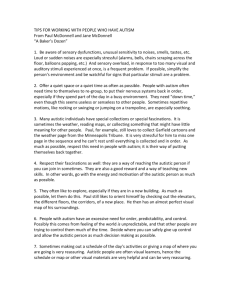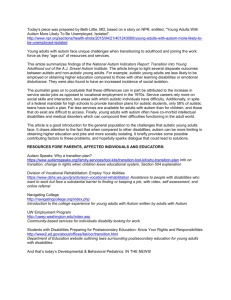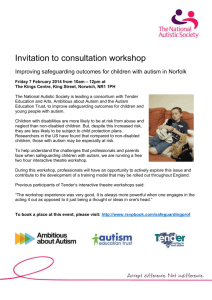My Mind is a Web Browser: How People with Autism Think
advertisement

My Mind is a Web Browser: How People with Autism Think by Temple Grandin Cerebrum, 2000 Winter Vol. 2, Number 1, pp. 14-22 The Charles A. Dana Foundation, New York, NY The struggle that made possible Temple Grandin's early development, graduate education, and notable career as a professor of animal behavior, designer of animal facilities worldwide, and celebrated writer, speaker, and researcher on autism, is told in her books, Emergence: Labeled Autistic (1986) and Thinking in Pictures and Other Reports From My Life With Autism* (Vintage Books) 1996. * Voted a Cerebrum "Great Brain Book," Spring 1999. Since writing Thinking in Pictures, which described my visual way of thinking, I have gained further insights into how my thought processes are different when compared to those of people who think in language. At autism meetings, I am often asked, "How can you be effective at public speaking when you think in pictures that are like video tapes in your imagination?" It is almost as though I have two levels of consciousness that operate separately. Only by interviewing people did I learn that many of them think primarily in words, and that their thoughts are linked to emotion. In my brain, words act as a narrator for the visual images in my imagination. I can see the pictures in my memory files. To use a computer analogy: The language part of my brain is the computer operator, and the rest of my brain is the computer. In most people, the brain's computer operator and the computer are merged into one seamless consciousness; but in me they are separate. I hypothesize that the frontal cortex of my brain is the operator and the rest of my brain is the computer. When I lecture, the language itself is mostly "downloaded" out of memory from files that are like tape recordings. I use slides or notes to trigger opening the different files. When I am talking about something for the first time, I look at the visual images on the "computer monitor" in my imagination, then the language part of me describes those images. After I have given the lecture several times, the new material in language is switched over into "audio tape-recording files." When I was in high school, other kids called me "tape recorder." A Web browser finds specific words; by analogy, my mind looks for picture memories that are associated with a word. It can also go off on a tangent in the same way as a Web browser. Non-autistic people seem to have a whole upper layer of verbal thinking that is merged with their emotions. By contrast, unless I panic, I use logic to make all decisions; my thinking can be done independently of emotion. In fact, I seem to lack a higher consciousness composed of abstract verbal thoughts that are merged with emotion. Researchers have learned that people with autism have a decreased metabolism in the area in the frontal cortex that connects the brain's emotional centers with higher thinking (the anterior cingulate). 1 The frontal cortex is the brain's senior executive like the CEO of a corporation. Brain scans indicate that people with autism use problem-solving circuits in social situations. Unlike non-autistic people, the emotion center in their amygdala is not activated, for example, when they judge expressions in another person's eyes.2 My mind is a Web browser Now let me explain how the language part of my brain and the "thinking in pictures" part of my brain seem to interact. My mind works just like an Internet Web browser. A Web browser finds specific words; by analogy, my mind looks for picture memories that are associated with a word. It can also go off on a tangent in the same way as a Web browser, because visual thinking is non-linear, associative thinking. To demonstrate how my mind works, at an autism meeting I asked a member of the audience to name a thing for me to invent. I wanted to show how the visual part of my brain and the language part worked separately. Somebody said, "invent a better paper clip." The language part of my brain said, "I can do that," and pictures immediately started flashing into my imagination of all kinds of paper clips I have seen. My "Web browser" searched the picture memory files; many paper clip pictures flashed through my imagination like slides. I could stop on any one picture and study it. I saw an odd, plastic paper clip that was on a scientific paper from Europe. At this point, I got off the subject and saw pictures of the first scientific meeting I had attended in Spain. The language voice inside me said, "Get back on the subject of paper clips." The language part of me is a manager who uses simple non-descriptive language to tell the rest of my brain what to do. Often, the best ideas for inventing things come just as I am drifting off to sleep. The pictures are clearer then. It is as though I can access the most concrete, vivid memory files with the most detailed images. The language part of my brain is completely shut off at night. To get ideas for new paper clip designs, I can pull up pictures of clothes pins and other clip-like things, such as mouse traps and C clamps used in woodworking. I start thinking that inventing a better clip for holding a thick pile of papers together might be more marketable than a new paper clip design. Existing spring binder clips tend to rip envelopes when papers are mailed, because the clips have protruding edges. When I think about this, I see ripped envelopes. The language part of my mind says, "Design a flat binder clip for thick documents." When I say this, I see a mailed document in an undamaged envelope. My visual imagination then sees a large plastic clip that I saw in Japan. Japanese apartment dwellers who do not have clothes dryers use large, plastic clips to hold blankets and other laundry on balcony railings. A small version of the Japanese balcony clip may make a better paper clip for holding many pages. When I was responding to the paper clip inquiry, I knew that I could visually associate all day about paper clips. The language part of my mind then said, "That is enough," and I resumed my lecture. But as I corrected the first draft of this article, I saw a one-piece molded plastic binder clip that would lay flat on a thick bunch of papers. I do have the ability to control the rate at which pictures come onto the "computer screen" in my imagination. Some people with autism are not able to do this. One person with autism told me that images explode into a web of a pictures that are interrelated. The decision-making process can become "locked up" and over-loaded with pictures coming in all at once. Unmasking Talent I have been fascinated with research indicating that the detailed, realistic pictures that autistic savants -- autistic individuals with extraordinary talent in a specific area -- make may be created by directly accessing primary memory areas deep in the brain. Researchers in Australia hypothesize that autistic savants may have privileged access to lower levels of information. 3 A study with a non-autistic "human calculator," who could solve multiplication problems twice as quickly as a normal person, indicated that his brain had enhanced low-level processing. 4 EEG recordings of his brain waves showed that brain activity was greatest, as compared with a normal person, when the multiplication problem was first flashed on the screen. I hypothesize that I am able to access primary visual files in my brain. When designing livestock equipment in my business, I can do three-dimensional, full motion videos of equipment and can test-run the equipment in my imagination. I can walk around it or fly over it. My ability to rotate the image is slow. I move my mind's eye around or over the image. When I read an article in Neurology about frontal temporal lobe dementia, I became extremely excited. It provided a scientific foundation for the idea of hidden visual thinking under a layer of verbal thinking. Research on frontal temporal lobe dementia, an Alzheimer's-like condition that destroys language and social areas in the brain, demonstrated that, as the condition progressed, visual skills in art emerged in people who had no interest in art. The increase in creativity was always visual, never verbal. Brain scans found the highest activity in the visual cortex. As the patient's cognitive abilities deteriorated, the art became more photo realistic. Artwork published with the journal article looks like the art of autistic savants. I see the decision process I see the decision-making process in my mind in a way most people do not. When I tried to explain this to a person who thinks in language, he just didn't get it. How my decision-making works is most clearly seen in an emergency. On a bright, sunny day, I was driving to the airport when an elk ran into the highway just ahead of my car. I had only three or four seconds to react. During those few seconds, I saw images of my choices. The first image was of a car rear ending me. This is what would have happened if I had made the instinctive panic response and slammed on the brakes. The second image was of an elk smashing through my windshield. This is what would have happened if I had swerved. The last image showed the elk passing by in front of my car. The last choice was the one I could make if I inhibited the panic response and braked just a little to slow the car. I mentally "clicked" on slowing down and avoided an accident. It was like clicking a computer mouse on the desired picture. Animal decision making I speculate that the decision-making process I used to avoid the accident may be similar to the process animals use. From my work with animals, I've come to believe that consciousness originally arose from the orienting response. When a deer sees a person, it will often freeze and look at him. This is the deer's orienting response. During this time, it decides either to run away or to keep grazing. It does not act as a programmed robot, governed by instinct or reflexes; it has the flexibility to make a decision. One of the things that has helped me to understand animals is that, more than most people, I think and feel like one. The more "animal" parts of the normal human brain may be covered by layers of language-based thinking. Thinking in audio tapes In connection with my lectures, I have talked with autistic people who are not visual thinkers. They seem to think in audio tape clips. Audio tape thinking does not have to involve language; instead of using visual images to form memories, these people store very specific audio clips. I suspect that, for them, hearing is easier than seeing. Dr. John Stein and his colleagues at Oxford University have discovered that some people have difficulty seeing rapidly changing visual scenes. They find reading is difficult because the print appears jumbled. 6 This results from defects in brain circuits that process motion.7 The eye is fine; the circuits between brain and eyes malfunction. One person I know who is expert at training animals told me that she hears the animal's behavior instead of seeing it. She has audio tapes in her memory with little sound details. For example, she knows that the animal is relaxed or agitated by listening to its breathing or footsteps. She reads audio signals instead of body posture. Piecing the details together People with autism, and animals as well, pay more attention to details. As I described in Thinking in Pictures, all my thinking goes from the specific to the general. I look at lots of little details and piece them together to make a concept. The first step in forming an idea is to make categories. For example, the most primary level is sorting objects by color or shape. The next step is sorting things by less obvious features, as when we categorize cats and dogs. When I was five years old, I figured out that a miniature dachshund was not a cat because it had a dog's nose; all dogs had certain features that were visually recognizable. My mind seeks these categories amidst an array of little details. In problem solving, my thinking process is like that of an epidemiologist tracking down a disease. The epidemiologist collects lots of little pieces of information and finally figures out the common factor that caused certain people to fall ill. For example, they may all have eaten strawberries from a certain place. Also, I understand concepts visually. For example, all objects classified as keys will open locks. I realize that the word "key" can also be used metaphorically, when we say, "the key to success is positive thinking." When I think about that phrase, I see Norman Vincent Peale's book, The Power of Positive Thinking, and I see myself back at my aunt's ranch reading it. I then see a stage where a person is getting an award and I see a large cardboard key. Even in this situation, the key still unlocks the door to success. The ability to form categories is the beginning of the ability to form concepts. Keys in their physical form open physical locks but abstract keys can open many things, such as a scientific discovery or career success. In teaching people to understand animal behavior, I have to help them to learn how to observe details that seem insignificant. Animals notice details in their environment that most people do not see, such as a branch that moves slightly or a shadow. In my work with livestock facilities, I try to get the language-based thinkers of the crowd to be more observant of little details that spook cattle. A cow may balk at entering a vaccination chute because it sees a piece of jiggling chain that most people ignore, but which is significant in the cow's environment. That little chain attracts the cow's attention because it moves quickly. Rapid movement activates the amygdala, the brain's emotion center. In a prey species such as cattle, rapid movement elevates fear because, in the wild, things that move rapidly are often dangerous. Something moving quickly in the bushes may be a lion. On the other hand, a predatory animal such as a dog, is attracted to rapid movement. This may explain why some dogs attack joggers. Rapid movement triggers chasing and attacking in a predatory animal, but it triggers flight in a prey species such as deer or cattle. Objects that move rapidly also attract the attention of people with autism. When I was younger, I liked to play with automatic doors at supermarkets. I enjoyed watching the rapid opening movement. Elevator doors were not interesting; they did not move fast enough to be pleasurable to watch. Tests of my visual tracking indicate that I have a slight abnormality in my eye's ability to track a moving object. Children and adults with autism who never learn to speak have graver defects in their nervous system. The automatic doors that I liked to watch cause many nonverbal autistics to put their hands over their eyes. The rapid movement of the doors hurts their eyes. Possibly, a small defect in eye tracking makes rapidly moving things attractive to me, while a more serious neurological defect makes them unpleasant to other autistics. As a child, my favorite things all made rapid movements. I liked flapping flags, kites, and model airplanes that flew. Disturbing sounds I have always felt that my senses were more like those of an animal. Does my brain have deeper access to the ancient anti-predator circuits that humans share with animals? At night, I cannot get to sleep if I hear high-pitched, intermittent noise such as a backup alarm on a truck or children yelling in the next hotel room; they make my heart race. Thunder or airport noise does not bother me, but the little high-pitched noises cannot be shut out. Recent research with pigs has confirmed that intermittent sounds are more disturbing to them than steady sounds.9 Why are high-pitched sounds disturbing to animals (and to me), while airport noises and thunder are not? I speculate that in nature the rumble of thunder is not dangerous but a high-pitched noise would be an animal's distress call. Beeping backup alarms and car alarms are electronic distress calls, which activate my nervous system even though I know they are harmless. It is almost as though these animal circuits in my brain have been laid bare. Proportional thinking A recent report in Science indicated that activities involving numbers are processed in at least two different parts of the brain.10 Precise calculations are dependent on language and are processed in the frontal areas; proportional figuring is processed in visual areas. Proportional thinking is figuring out if one object is less or more than another. For example, three marbles are more than one marble. Animals can do proportional thinking. They can easily determine that 10 pieces of food are more than two. It is likely that proportional thinking is the kind of number processing that humans share with animals. In school, math was a tough subject for me. Finding the precisely correct answer is difficult because I mix up numbers. On the other hand, I am very good at proportional thinking, coming up with an accurate approximate answer. In my scientific work, I often convert numerical differences between my control and experimental groups to percentage differences. Percentage differences can be visualized on a pie chart. When I present data, I like to use charts and graphs so I can see the proportional differences between different sets of data. When I did cost estimating for cattle industry construction projects, I never tried to calculate projects to the penny. Instead, I estimated the cost of a new job by figuring out its proportional cost in relation to other finished projects. This was mainly a visual process. I would look at the drawing and build the entire project in my imagination. I then would put it up on the video screen in my imagination and compare it in size to other completed projects that had complete cost figures. In my mind, I could compare four or five completed projects with the drawing I was estimating. The project being estimated might be equal to two-thirds of a cattle-handling facility that I designed at Red River Feedlot and about 25 percent bigger than a corral I designed for Lone Mountain Ranch. For money to have meaning to me, it must be related to something I can buy with it, otherwise it is too abstract. For example, $3 is equal to lunch at McDonald's, $20 is a tank of gas, and $1000 can buy a computer. Big tables full of figures make little sense to me. Some more severely autistic people do not understand money at all. For me to understand a billion dollars, I have to have a picture in my mind of something that cost a billion dollars. One billion is one quarter of the cost of the new Denver Airport. When President Clinton announced part way through the war in Kosovo that it had cost $2 billion, I figured that half a Denver Airport worth of money had been spent. Different amounts of money have different visual values. It is interesting that proportional thinking for numbers is in the visual parts of the brain. In proportional thinking, as in creating something new, making a decision, and forming concepts, my thinking relies on more direct access to the primary visual memory areas in my brain. There is a whole higher level of abstract thinking seamlessly linked to emotion that I do not have. References 1. Haznedar MM, Buchsbaum MS, Metzer M, et at. Anterior cingulate gyrus volume and glucose metabolism in autistic disorder. American Journal of Psychiatry. 1997: 154:1047-1050. 2. Baron-Cohen S, Ring HA, Wheelwright S. Social intelligence in the normal and autistic brain: an FMRI study. European Journal of Neuroscience. 1999: 11:1891.1898. 3. Snyder AW, Mitchell JD. Is integer arithmetic fundamental to mental processing? The mind's secret arithmetic. Proceedings of the Royal Society of London. 1999:266:-587-592. 4. Birbaumer N. Rain Man's revelations. Nature. 1999:399:211-212. 5. Miller BL, Cummings J, Mishkin F. Emergence of artistic talent in froniotemporal dementia. Neurology. 1998:51:978-982. 6. Clayton J. Lost for Words. New Scientist. April 24, 1999. pp.27-30. 7. Eden GF, Van Meter JW, Ramsey J, et al. Abnormal processing of artistic talent in dyslexia revealed by functional brain imaging. Nature. 1996: 382:66-69. 8. LeDoux J. The Emotional Brain. Simon and Schuster; 1996. 9. Talling JC, Waran NK, Wathes CM. Sound avoidance by domestic pigs depends on the characteristics of the signal. Applied Animal Behavior Science. 1998:58: 255-266. 10. Dehaene S, Spelke E, Pinel P, Stanescu R, Tsivkin S. Sources of mathematical thinking: Behavioral and brain imaging evidence. Science. 1999: 284:970-973. .






